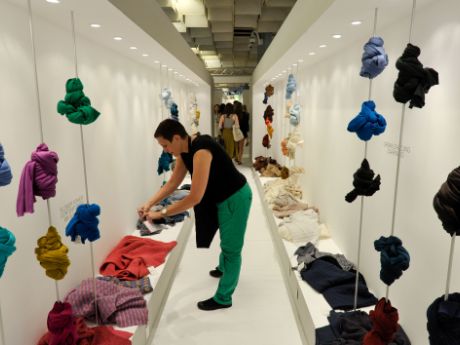
Decision on Pitti Filati 87 postponed until May
Pitti Immagine Filati Florence opened with optimism and closed with satisfaction. Buyer numbers were up, foreign buyers +7.4% - especially from Japan and the US. The total numbered around 5,250 buyers. Spinners reported that they were looking seriously for a quality offer with strong fashion content but also were extremely price sensitive. Since the 69th edition of the fair, 5-7th July, Italy has voted t

18th July 2011
Knitting Industry
|
Florence

Pitti Immagine Filati Florence opened with optimism and closed with satisfaction. Buyer numbers were up, foreign buyers +7.4% - especially from Japan and the US. The total numbered around 5,250 buyers. Spinners reported that they were looking seriously for a quality offer with strong fashion content but also were extremely price sensitive.
Since the 69th edition of the fair, 5-7th July, Italy has voted through austerity measures which will constrain the domestic economy. This was a hot topic for exhibitors and buyers during the week. Many companies have recovered a good level of profitability in the last year, and there is confidence in the ability of the sector to increase exports and mitigate some of the domestic constraints.
 The high quality spinners who exhibit at Filati pride themselves on creativity and research. They supply haute couture, brands, and some now look at the middle market. Precious animal fibres, but also synthetics and viscose are in the frame.
The high quality spinners who exhibit at Filati pride themselves on creativity and research. They supply haute couture, brands, and some now look at the middle market. Precious animal fibres, but also synthetics and viscose are in the frame.
Special finishes and effects were key, for both pure and blended yarns; washable wool, like Total Easy Care wool NM 2/30.00 Olympias; subtle shine, 3d looks, soft and pliable linen blends.
Marrying precious fibres and synthetics gave particular effects, wool /viscose and polyamide novel for matt/shine contrast- Filpucci. The return of synthetics came last season with an increase in blends. Now there are many - wool/polyamide 80/20 Olympias, cotton/ polycotton, Miroglio. Many spinners say that they are making a conscious effort to bring down prices without affecting quality.
Extrafine wool and pure cashmere still dominate for the season. Alpaca, the favoured ‘new' yarn of the season, is mixed with wool, cotton, polycotton and nylon, as at Pecci, in blends with linen and wool, or mixed with nylon and elastan.
Puffy woollen yarns, airspun and fluffed are destined for fashionable chunky soft knits with organic structures and traditional patterns - coarse gauge stitch interest and twisted rope themes. Finer fishing net effects in gold and silver yarns play on natural irregularities. Natural landscape colours for cashmere are soft and appealed to buyers, as at Todd & Duncan. Thick yarns in Donegal designs and ecru wools underlined the continuing demand for handmade looks, usually soft and very light for thicker, more substantial winter sweaters and outer knits.
Regal darks for winter feature deep blue, black, purple, royal red, sometimes with iridescence. Cariaggi's ‘perle' - small glass beads embedded in the yarn, impart subtle shine; underplayed Lurex yarns provide luminosity at Filpucci, Loro Piana, Ilari, countering dark plain stitches. Reflective surfaces come via metallised yarns, or shiny polyamide, knitted with kid mohair in fine web-like structures at Filpucci.
 Many companies have realised the value of demonstrating their yarns, often using the talents of students to interpret the new season's offer. Zegna Baruffa have continuing links with international design departments, with designer work on show, and Cariaggi sponsors a knitwear student at the Royal College of Art, London. This year's second ‘Feel the Yarn' competition at the show, organised by Ornella Bignami had the support of both national and the Tuscan regional government in Italy. Selected knitwear students from colleges in London, New York, Beijing, Tokyo and Sao Paolo took their pick of new, expensive yarns from Tuscan spinners to create individual garments, judged by over 500 buyers at the fair and a Jury of international technical judges.
Many companies have realised the value of demonstrating their yarns, often using the talents of students to interpret the new season's offer. Zegna Baruffa have continuing links with international design departments, with designer work on show, and Cariaggi sponsors a knitwear student at the Royal College of Art, London. This year's second ‘Feel the Yarn' competition at the show, organised by Ornella Bignami had the support of both national and the Tuscan regional government in Italy. Selected knitwear students from colleges in London, New York, Beijing, Tokyo and Sao Paolo took their pick of new, expensive yarns from Tuscan spinners to create individual garments, judged by over 500 buyers at the fair and a Jury of international technical judges.
Recycling, the theme of the trend area at the show is being put forward as a major influence on marketing and production for the West, with known benefits accruing in terms of traceability, quality and cachet. Various companies have moved their green credentials higher up the list in response to a definite move from the quality sector to capitalise on areas where they can score by investing in machinery and techniques.
Many forms of recycling are now being offered, yarn made from off cuts from knitting, PET reprocessing for eco yarns in malleable polyester and the recuperation of clothing for yarn, re-spun and finished. The emphasis is now on proving to the fashion and retail trade that these yarns look good, perform well and boost the supply of sometimes dwindling amounts of particular fibres. Cashmere in particular is one of the fibres which companies are looking at for wholesale reprocessing, with high quality yarn the end result. With yarn scarcity still a problem; it is a way to secure more supplies. ‘Green' approaches have caught the current mood.
Pitti Filati showed that producers of top of the range cashmere and extrafine wool spun products are seeking to capitalise their strengths. They are editing their collections down to reduce sampling costs, but also to put forward a confident, coherent view for the season. Dozens of colours and qualities are now kept in stock to react to markets which are wary of commitment, but likely to require yarn at short notice.

Business intelligence for the fibre, textiles and apparel industries: technologies, innovations, markets, investments, trade policy, sourcing, strategy...
Find out more